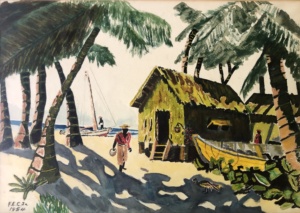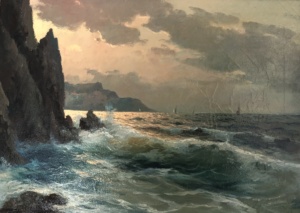Brilliant Effects

On February 21, 1950, Fuller Callaway Jr. wrote to his 14-year-old daughter Ida, who was attending Mount Vernon Seminary in Washington, D.C.
“I have been so busy since returning home that I have had no time to paint at all. Maybe when we get back from Miami, I will have time to get another picture started before you come home.”
This is the earliest reference we have of Fuller’s artistic pursuits, an interest that lasted nearly a decade and blossomed into a lifelong love of art. Exactly when he started painting is uncertain, but it seems to roughly coincide with his decision in the fall of 1945 to step down as president of Callaway Mills and take a ten-year sabbatical to explore other interests.
Fuller had a natural teacher in his friend and neighbor, Lamar Dodd, who would have an acclaimed career as an artist and head of the art department at the University of Georgia. Sometime in the 1940s, Dodd began providing art lessons to Fuller, and these continued off and on for a number of years. On December 30, 1952, he received a letter from Dodd that said:
“I don’t know whether you know it or not, but I really enjoyed those sessions with you. I got a tremendous kick out of seeing what you did, and the suggestions I made.”
The letter went on to detail all the art supplies he had selected and shipped to his student: paint brushes, paints, pastels, palette knifes, and sketchbooks. Accompanying the supplies were specific instructions:
“….there is a box of soft pastels. Use these freely. Try them on several different types of paper – but remember you will need a “toothy” paper for pastel. I have sent you two different types of sketch books, and before our paths cross again I want all of these filled.”
“Note the one-pound tube of Underpainting White. It is a recent development, and it is wonderful. Apply this white with either your painting knife or brush. In an hour’s time, it is thoroughly dry and you can glaze over the surface. I put in two tubes of Ponsol color – a yellow and a blue. These are used for glazing over that white, and you can get other colors after you have tried these. Notice what brilliant effects can be secured…I also put in a tube of watercolor – Mars Violet – which I believe you will enjoy.”
Fuller responded back within a matter of days:
“I have already put the pastels, charcoal, and some of the sketch paper into use…The ‘Lesson’ which you gave me during the Christmas holidays was thoroughly enjoyed and greatly appreciated. You were certainly generous to give me so much of your time during the holiday.”
Shortly thereafter Dodd expressed that he was mighty curious how the painting was progressing. He sent more brushes:
“The pre-war Rubens bristle brushes are available again and haven’t been available since before the war.”
Fuller responded with thanks for the comments on his progress, which served as an inspiration:
“I shall strive to do better. I really appreciate your kind words relative to my amateur art.”
The correspondence continued throughout 1953. Fuller, an expert amateur photographer, provided Dodd guidance on how to use his Minox camera and ordered film and a tripod for Dodd, who was planning to do photography on an upcoming trip to Italy. He was also invited to several gallery shows that featured Dodd’s newest award-winning art. The letters back and forth reached a crescendo in December when Fuller wrote:
“During the last few weeks, I have found time to do quite a bit of painting and have at least achieved my goal of getting a ‘Callaway’ hung on the first floor of Alice’s house. In fact, she now has it hung in the library in place of your ‘Sail Boats’! You see I am nosing you out while you are gone far across the water.”
Lamar responded:
“…it makes me very happy to hear you have been painting again – even if it means replacing the ‘Sail Boats’. Is Alice’s taste improving or could it be that Fuller’s paintings are? Regardless of what brought about the change I am happy.”
All told, Fuller created at least two dozen works of art, most of which are in private collections and some of which he appears to have framed himself. The pieces include oil paintings, pastels, charcoals sketches, and a few watercolors. In at least one instance, a pastel sketch was completed in preparation for doing an oil painting of the same scene, a technique he may have regularly employed. Most of his oil paintings are signed and dated between 1953 and 1956, which was the peak of his art exploration. While many of the less formal sketches are not signed, their provenance and style strongly suggest that he did them.
Landscapes were clearly his favorite subject, but architecture was also prominently featured as he worked to master perspective, something he struggled to perfect. There are at least two sketches of Hills & Dales, and he sometimes created illustrations of houses for friends. Fuller painted the old Mitchell home on Hill Street for his lifelong friend, Katie Mitchell Lynn, and the home of his brother Cason after it had been purchased by Arthur B. Edge Jr., who served as president of Callaway Mills for many years. Since he was such a talented photographer, we believe he painted from photographs, but some works may have been imagined or created on site.
While most of his art is realistic, there are several abstract pieces that are stylistically similar to paintings that he purchased from various art galleries in New York and Florida. They feature bold strokes and colors reminiscent of van Gogh. This interest in abstraction may have been gleaned from Dodd, whose own painting became less representational as his career progressed. There are also works of people and animals including Marilyn Monroe, a young man, Santa, and a dog, perhaps one of his own.
There are several family stories that add a human element to his artwork. On one occasion, after Dodd had visited LaGrange, Fuller could not find his Burnt Sienna paint anywhere. After searching, he reached out to ask him if he knew of its whereabouts. Dodd responded that he took it away because Fuller was using it too much! Even more revealing and personal was the occasion when Alice approved hanging his seascape in the Library. However, since the rocky coastline was on the left side, it threw the room out of balance. Fuller proceeded to paint a second version with the rocks on the right, creating balance in the room and in the family. This story is authenticated by the survival of the two seascapes.
Painting was just one facet of Fuller’s complex life. He certainly enjoyed this creative pursuit, but after returning to work at the mills in the mid-1950s, his leisure time dwindled. Although he was not actively engaged in painting, his interest in the arts continued unabated. He visited galleries, purchased works by a wide variety of artists, and amassed a modest collection of artwork, which he clearly cherished. He also went on to become a major patron of the arts with his support of the Chattahoochee Art Association, the Lamar Dodd Art Center at LaGrange College, and other regional art initiatives. Who would have imagined that those first brushstrokes guided by a lifelong friend would lead to such a legacy? -CBW

Harbor scene with boats, signed F.E.C Jr. |

Charcoal of Hills & Dales, created by Fuller Jr. in 1953. |

Tropical island scene created by Fuller Jr. in 1954. |

A tranquil Mediterranean scene painted by Fuller Jr. in 1953. |

This is the painting proposed for the Library at Hills & Dales. It was replaced by a second painting that depicted the rocky cliff on the right. Signed “F.E.C Jr. 1953.” |

This seascape with a rocky shore was painted in oil by Fuller Jr. in 1955. When Fuller signed paintings, he would print “F.E.C Jr.” followed by the year. |
View this entire Portico Newsletter: